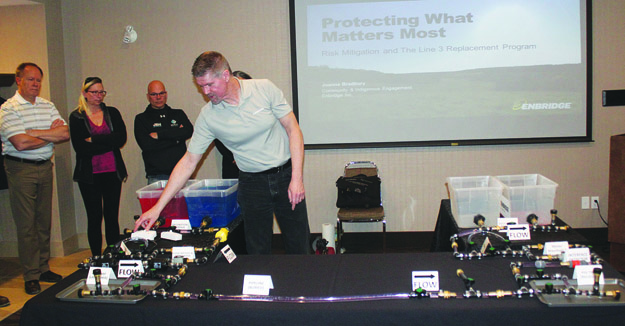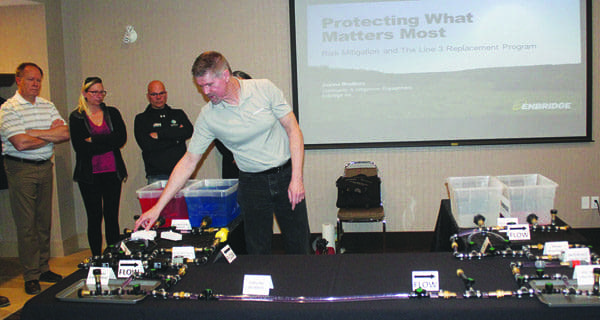
Peter Hansen, a senior adviser of community relations for Enbridge, demonstrates the functions of an oil pipeline using a working model at the luncheon hosted by the Kindersley and District Chamber of Commerce on April 24 at the Canalta Hotel Kindersley. Enbridge and project officials were at the luncheon to share details and answer people’s questions regarding the Line 3 Replacement Project.
Kenneth Brown
of The Clarion
The single largest project in Enbridge history is going to cut through the Kindersley area in 2018, and company officials are talking to local stakeholders.
Representatives from Enbridge were at the Canalta Hotel Kindersley on April 24 for a luncheon hosted by the Kindersley & District Chamber of Commerce. The pipeline company embarked on its Line 3 Replacement Project (L3RP) in 2017. The luncheon focused on L3RP.
There were several project officials at the luncheon including a representative from O.J. Pipelines, the lead contractor for work in the Kindersley area. Three officials from Enbridge were at the council meeting on April 23 to provide project details to town officials and to answer any of their questions.
The luncheon included a presentation by Joanne Bradbury, a community engagement strategist for Enbridge, and the event started with a table top demonstration by Peter Hansen, a senior advisor of community relations for Enbridge.
Bradbury, one of the company’s officials at the council meeting, spoke after lunch had been served. Her presentation was titled Risk Mitigation and the Line 3 Replacement Project. She introduced her colleagues at the meeting including two staff members from the company’s land services group.
She also introduced James Simpson, the project manager for O.J. Pipelines. Simpson was unable to attend the council meeting, but he was at the luncheon to represent the contractor and answer any questions people might want to ask, Bradbury said.
[emember_protected for=”2″ custom_msg=’For more on this story, please see the May 2 print edition of The Clarion.’]
The company operates 28,000 miles of active pipeline and transports 2.2 million barrels of crude oil through its pipelines per day, she said. Bradbury provided an overview of Enbridge, along with information about the company’s values and goals. Her slide show presentation included maps of pipelines.
Bradbury said the L3RP is replacing the entire line from Hardisty, Alta. to Superior, Wis. The line was built to the highest standard in 1968, but the lining has not been able to stand up to the test of time and the line needs to be replaced, she told her audience.
She focused on the project on the Canadian side of the border. She said more than 1,000 miles of pipeline will be replaced between Hardisty and Gretna, Man. The large project has nine construction spreads in total.
“In terms of scale, it’s a very significant project for Enbridge,” Bradbury said, referring to L3RP as a build and decommission project because the old line would remain in the ground and it will be decommissioned in line with regulations. “It is the biggest project that we’ve ever undertaken.”
The line replacement cuts a path right across Saskatchewan and the pipeline is a critical piece of energy infrastructure to support the economy, she said. Bradbury provided details of the regulated process that will be used to decommission the old line.
She noted that construction spreads 1, 3 and 4 were completed in 2017, so the company will work on spreads 2 and 5 to 9 in 2018. Spread two is through the Kindersley area and spreads 5 to 9 include everything east of Regina.
Bradbury said Enbridge does not replace the line, itself, so the company hires third-party pipeline contractors to do the work. The contractors are responsible for hiring a majority of sub-contractors for each spread. The field office for spread 2 will be located in Kindersley.
There is no way of knowing how many local workers will be hired, but the spread 2 work will require approximately 800 workers and they are going to need places to stay, she noted. The workers will also need to access local services.
The crews will work day shifts for six days per week, so Sunday is their only day off. Bradbury said she hopes local businesses including restaurants are able to adjust their hours to help meet the needs of the workers. The workers will need access to food and services in the evenings, on Sundays and during rain delays.
Bradbury said people should expect to see light activity starting in July, and then the work and influx of workers should ramp up toward the end of August. Enbridge will have about 100 people in the area, and the remaining workers will be from the contractors, according to the presenter.
“It’s very important that we make sure that the local business community is aware of what’s coming this summer,” she said, recognizing that Enbridge wants to maintain an open dialogue with all members of the community.
People heard that the company’s traffic management plan and bio-security are two very important aspects of the project. There will be an increase in traffic between 6 to 7 a.m., and in the early evenings after workers leave the project area for the day.
The majority of workers will take buses from communities to the job site, but people will still notice extra traffic as a result of the project. Highway 21 is expected to be very busy during the initial spread 2 work.
Joel McKim, a senior construction specialist for Enbridge, said the heaviest traffic will be in the rural municipalities. He noted that bio-security is a priority and the company does not want to spread invasive weeds or have any negative impacts on the land. Vehicle washes, haircuts and laundry services will be important, he added.
People were encouraged to let community groups know about funding opportunities because Enbridge will be investing in local communities. Groups could visit www.enbridge.com/funding to complete funding applications for community projects and initiatives.
Hansen had a small scale pipeline system set up to demonstrate how a pipeline operates. The demonstration included information on how the line is cleaned, and how oil in the line gets separated for different customers. Brenda Meyer, the chamber’s vice-president, thanked the project officials.
[/emember_protected]

